Analyzing Frank's All-American BarBeQue: Expansion & Customer Value
VerifiedAdded on 2023/04/20
|5
|1341
|492
Case Study
AI Summary
This case study examines Frank's All-American BarBeQue, focusing on Robert Rainsford's analysis of his father's business and potential expansion strategies. Robert evaluates the current customer value, highlighting strengths in functional, emotional, and social merits, while identifying gaps in epistemic and conditional value. He assesses perceived costs, noting an overemphasis on monetary aspects and neglect of time and psychic costs. The study further explores five expansion concepts: larger location, takeout options, inventory control, new restaurant locations, web marketing, and expanded sauce sales, linking each to customer value dimensions. Robert considers the importance of price elasticity and the impact of expansion on social, functional, and conditional merits, offering a comprehensive evaluation of the business's strategic options.
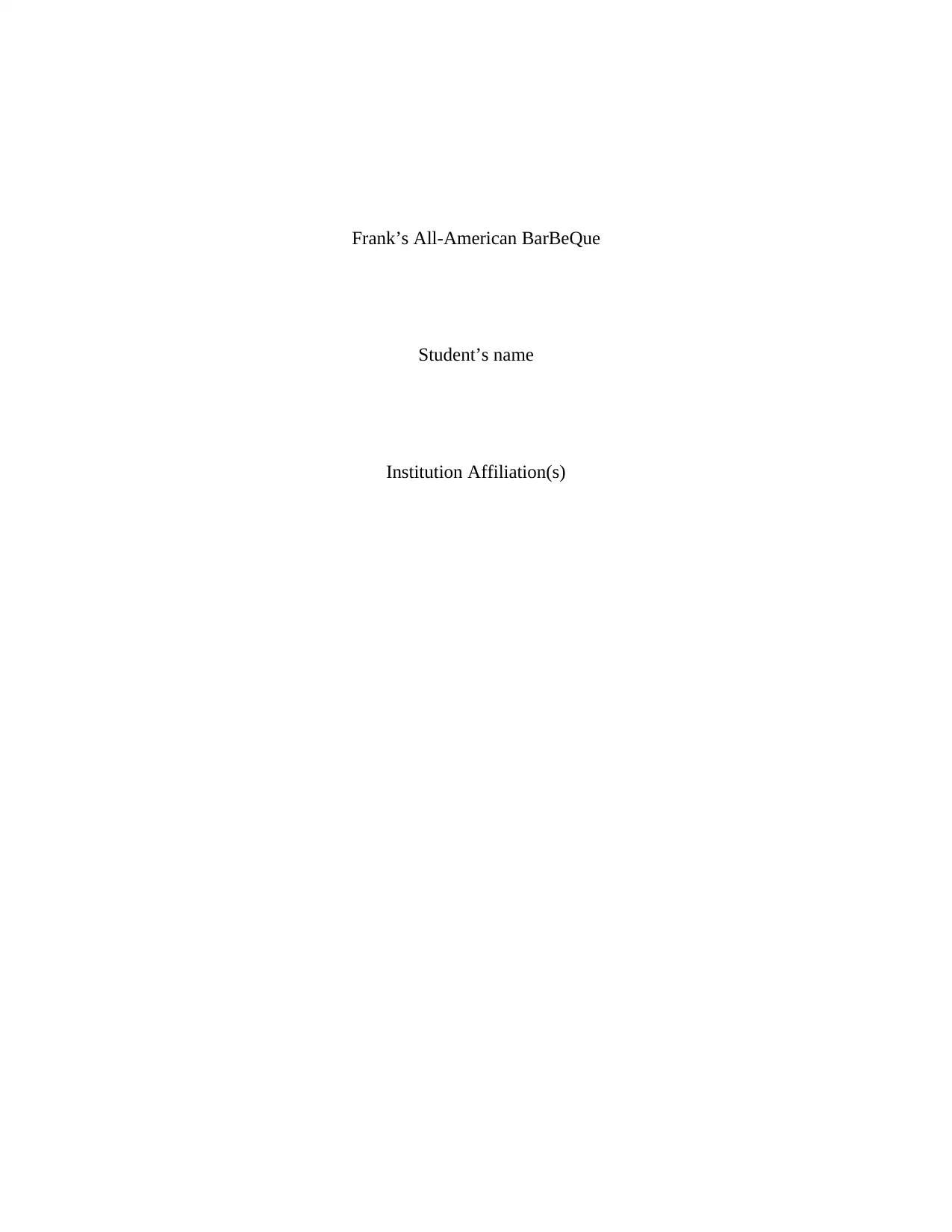
Frank’s All-American BarBeQue
Student’s name
Institution Affiliation(s)
Student’s name
Institution Affiliation(s)
Paraphrase This Document
Need a fresh take? Get an instant paraphrase of this document with our AI Paraphraser
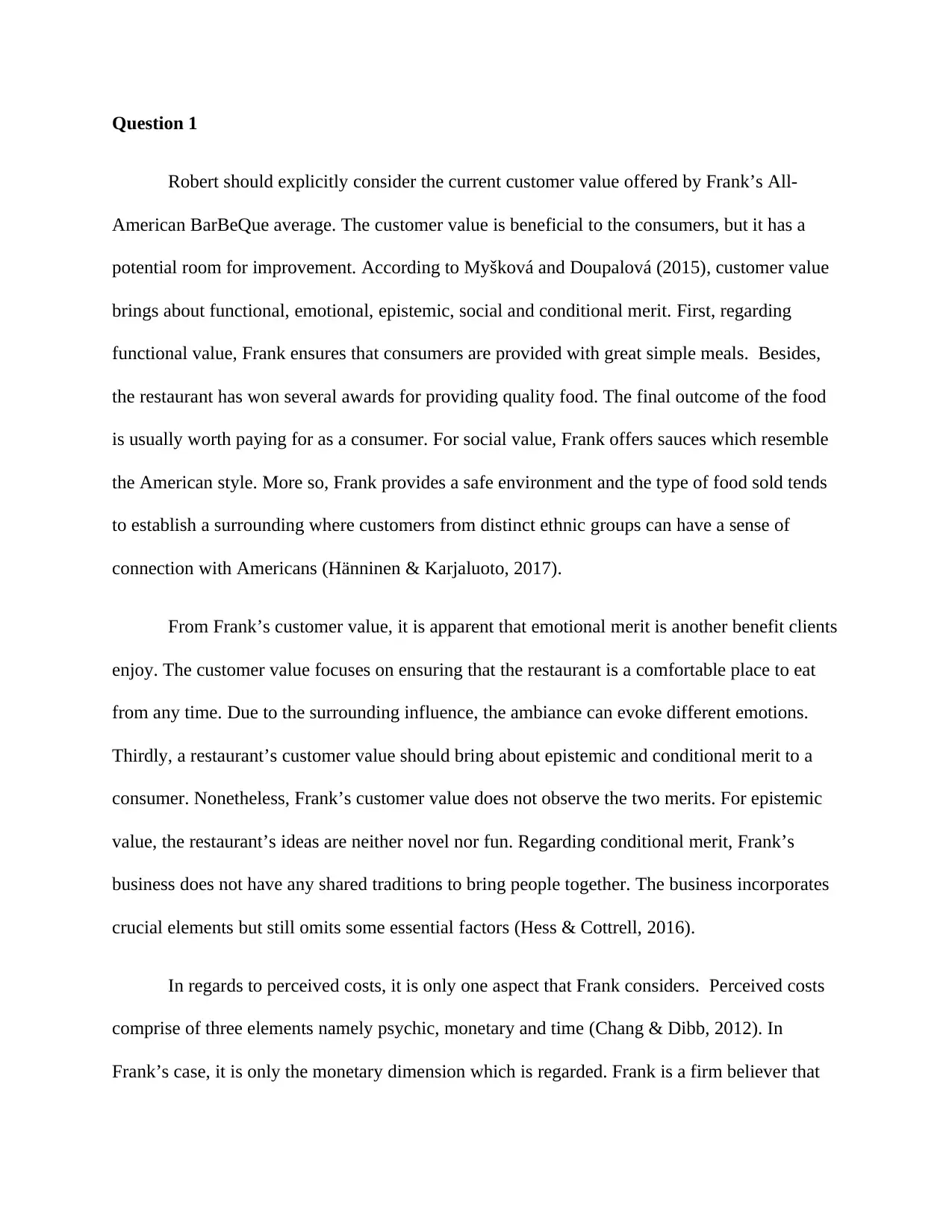
Question 1
Robert should explicitly consider the current customer value offered by Frank’s All-
American BarBeQue average. The customer value is beneficial to the consumers, but it has a
potential room for improvement. According to Myšková and Doupalová (2015), customer value
brings about functional, emotional, epistemic, social and conditional merit. First, regarding
functional value, Frank ensures that consumers are provided with great simple meals. Besides,
the restaurant has won several awards for providing quality food. The final outcome of the food
is usually worth paying for as a consumer. For social value, Frank offers sauces which resemble
the American style. More so, Frank provides a safe environment and the type of food sold tends
to establish a surrounding where customers from distinct ethnic groups can have a sense of
connection with Americans (Hänninen & Karjaluoto, 2017).
From Frank’s customer value, it is apparent that emotional merit is another benefit clients
enjoy. The customer value focuses on ensuring that the restaurant is a comfortable place to eat
from any time. Due to the surrounding influence, the ambiance can evoke different emotions.
Thirdly, a restaurant’s customer value should bring about epistemic and conditional merit to a
consumer. Nonetheless, Frank’s customer value does not observe the two merits. For epistemic
value, the restaurant’s ideas are neither novel nor fun. Regarding conditional merit, Frank’s
business does not have any shared traditions to bring people together. The business incorporates
crucial elements but still omits some essential factors (Hess & Cottrell, 2016).
In regards to perceived costs, it is only one aspect that Frank considers. Perceived costs
comprise of three elements namely psychic, monetary and time (Chang & Dibb, 2012). In
Frank’s case, it is only the monetary dimension which is regarded. Frank is a firm believer that
Robert should explicitly consider the current customer value offered by Frank’s All-
American BarBeQue average. The customer value is beneficial to the consumers, but it has a
potential room for improvement. According to Myšková and Doupalová (2015), customer value
brings about functional, emotional, epistemic, social and conditional merit. First, regarding
functional value, Frank ensures that consumers are provided with great simple meals. Besides,
the restaurant has won several awards for providing quality food. The final outcome of the food
is usually worth paying for as a consumer. For social value, Frank offers sauces which resemble
the American style. More so, Frank provides a safe environment and the type of food sold tends
to establish a surrounding where customers from distinct ethnic groups can have a sense of
connection with Americans (Hänninen & Karjaluoto, 2017).
From Frank’s customer value, it is apparent that emotional merit is another benefit clients
enjoy. The customer value focuses on ensuring that the restaurant is a comfortable place to eat
from any time. Due to the surrounding influence, the ambiance can evoke different emotions.
Thirdly, a restaurant’s customer value should bring about epistemic and conditional merit to a
consumer. Nonetheless, Frank’s customer value does not observe the two merits. For epistemic
value, the restaurant’s ideas are neither novel nor fun. Regarding conditional merit, Frank’s
business does not have any shared traditions to bring people together. The business incorporates
crucial elements but still omits some essential factors (Hess & Cottrell, 2016).
In regards to perceived costs, it is only one aspect that Frank considers. Perceived costs
comprise of three elements namely psychic, monetary and time (Chang & Dibb, 2012). In
Frank’s case, it is only the monetary dimension which is regarded. Frank is a firm believer that
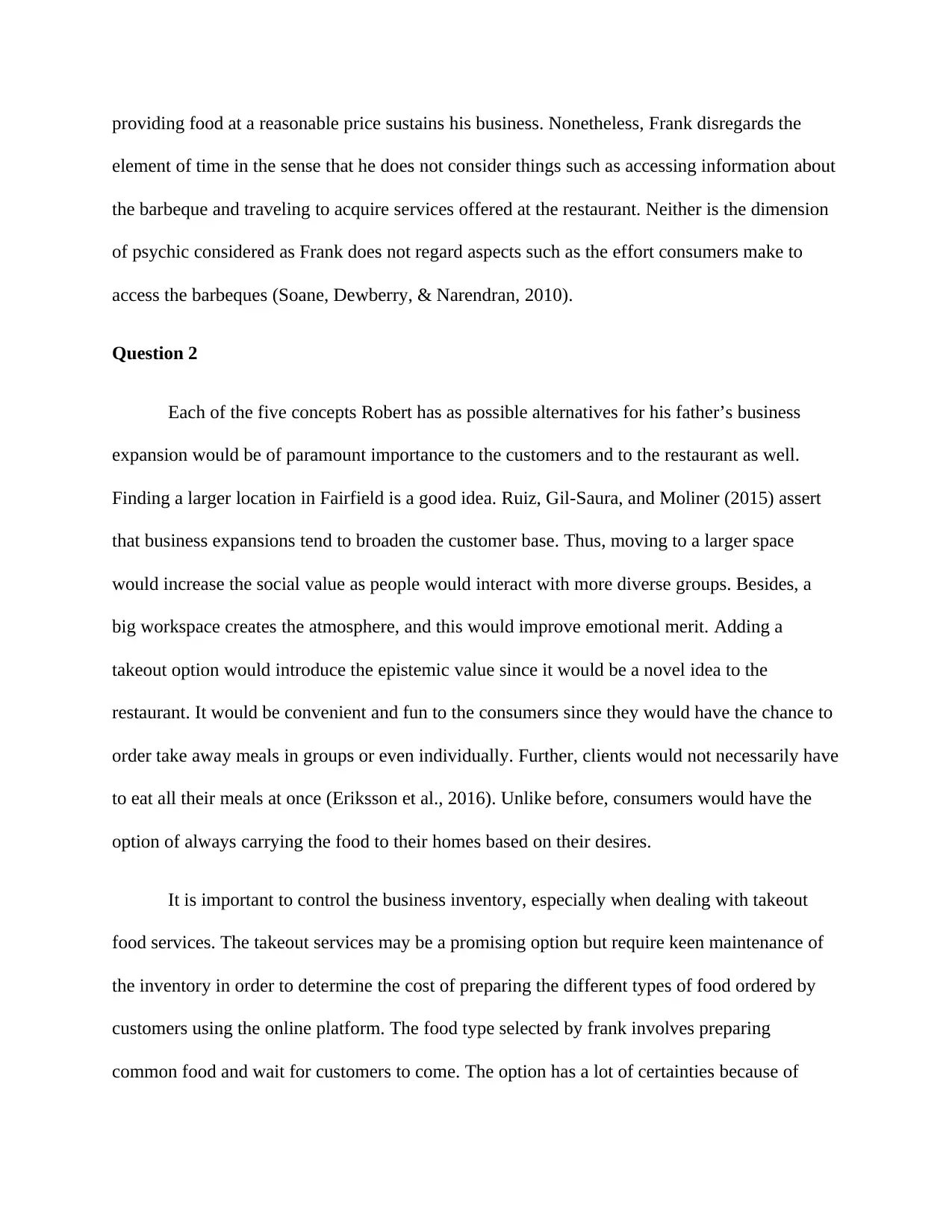
providing food at a reasonable price sustains his business. Nonetheless, Frank disregards the
element of time in the sense that he does not consider things such as accessing information about
the barbeque and traveling to acquire services offered at the restaurant. Neither is the dimension
of psychic considered as Frank does not regard aspects such as the effort consumers make to
access the barbeques (Soane, Dewberry, & Narendran, 2010).
Question 2
Each of the five concepts Robert has as possible alternatives for his father’s business
expansion would be of paramount importance to the customers and to the restaurant as well.
Finding a larger location in Fairfield is a good idea. Ruiz, Gil-Saura, and Moliner (2015) assert
that business expansions tend to broaden the customer base. Thus, moving to a larger space
would increase the social value as people would interact with more diverse groups. Besides, a
big workspace creates the atmosphere, and this would improve emotional merit. Adding a
takeout option would introduce the epistemic value since it would be a novel idea to the
restaurant. It would be convenient and fun to the consumers since they would have the chance to
order take away meals in groups or even individually. Further, clients would not necessarily have
to eat all their meals at once (Eriksson et al., 2016). Unlike before, consumers would have the
option of always carrying the food to their homes based on their desires.
It is important to control the business inventory, especially when dealing with takeout
food services. The takeout services may be a promising option but require keen maintenance of
the inventory in order to determine the cost of preparing the different types of food ordered by
customers using the online platform. The food type selected by frank involves preparing
common food and wait for customers to come. The option has a lot of certainties because of
element of time in the sense that he does not consider things such as accessing information about
the barbeque and traveling to acquire services offered at the restaurant. Neither is the dimension
of psychic considered as Frank does not regard aspects such as the effort consumers make to
access the barbeques (Soane, Dewberry, & Narendran, 2010).
Question 2
Each of the five concepts Robert has as possible alternatives for his father’s business
expansion would be of paramount importance to the customers and to the restaurant as well.
Finding a larger location in Fairfield is a good idea. Ruiz, Gil-Saura, and Moliner (2015) assert
that business expansions tend to broaden the customer base. Thus, moving to a larger space
would increase the social value as people would interact with more diverse groups. Besides, a
big workspace creates the atmosphere, and this would improve emotional merit. Adding a
takeout option would introduce the epistemic value since it would be a novel idea to the
restaurant. It would be convenient and fun to the consumers since they would have the chance to
order take away meals in groups or even individually. Further, clients would not necessarily have
to eat all their meals at once (Eriksson et al., 2016). Unlike before, consumers would have the
option of always carrying the food to their homes based on their desires.
It is important to control the business inventory, especially when dealing with takeout
food services. The takeout services may be a promising option but require keen maintenance of
the inventory in order to determine the cost of preparing the different types of food ordered by
customers using the online platform. The food type selected by frank involves preparing
common food and wait for customers to come. The option has a lot of certainties because of
⊘ This is a preview!⊘
Do you want full access?
Subscribe today to unlock all pages.

Trusted by 1+ million students worldwide
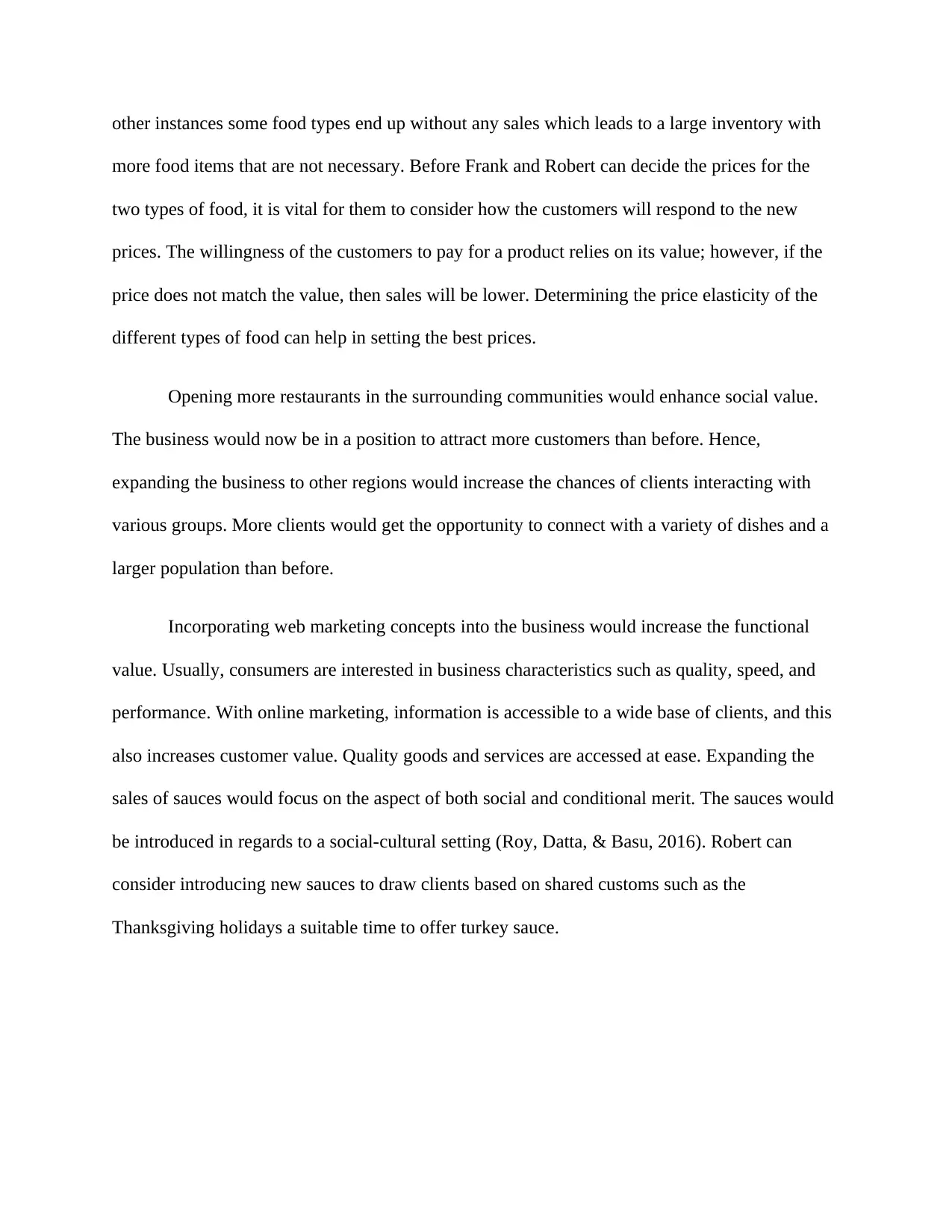
other instances some food types end up without any sales which leads to a large inventory with
more food items that are not necessary. Before Frank and Robert can decide the prices for the
two types of food, it is vital for them to consider how the customers will respond to the new
prices. The willingness of the customers to pay for a product relies on its value; however, if the
price does not match the value, then sales will be lower. Determining the price elasticity of the
different types of food can help in setting the best prices.
Opening more restaurants in the surrounding communities would enhance social value.
The business would now be in a position to attract more customers than before. Hence,
expanding the business to other regions would increase the chances of clients interacting with
various groups. More clients would get the opportunity to connect with a variety of dishes and a
larger population than before.
Incorporating web marketing concepts into the business would increase the functional
value. Usually, consumers are interested in business characteristics such as quality, speed, and
performance. With online marketing, information is accessible to a wide base of clients, and this
also increases customer value. Quality goods and services are accessed at ease. Expanding the
sales of sauces would focus on the aspect of both social and conditional merit. The sauces would
be introduced in regards to a social-cultural setting (Roy, Datta, & Basu, 2016). Robert can
consider introducing new sauces to draw clients based on shared customs such as the
Thanksgiving holidays a suitable time to offer turkey sauce.
more food items that are not necessary. Before Frank and Robert can decide the prices for the
two types of food, it is vital for them to consider how the customers will respond to the new
prices. The willingness of the customers to pay for a product relies on its value; however, if the
price does not match the value, then sales will be lower. Determining the price elasticity of the
different types of food can help in setting the best prices.
Opening more restaurants in the surrounding communities would enhance social value.
The business would now be in a position to attract more customers than before. Hence,
expanding the business to other regions would increase the chances of clients interacting with
various groups. More clients would get the opportunity to connect with a variety of dishes and a
larger population than before.
Incorporating web marketing concepts into the business would increase the functional
value. Usually, consumers are interested in business characteristics such as quality, speed, and
performance. With online marketing, information is accessible to a wide base of clients, and this
also increases customer value. Quality goods and services are accessed at ease. Expanding the
sales of sauces would focus on the aspect of both social and conditional merit. The sauces would
be introduced in regards to a social-cultural setting (Roy, Datta, & Basu, 2016). Robert can
consider introducing new sauces to draw clients based on shared customs such as the
Thanksgiving holidays a suitable time to offer turkey sauce.
Paraphrase This Document
Need a fresh take? Get an instant paraphrase of this document with our AI Paraphraser
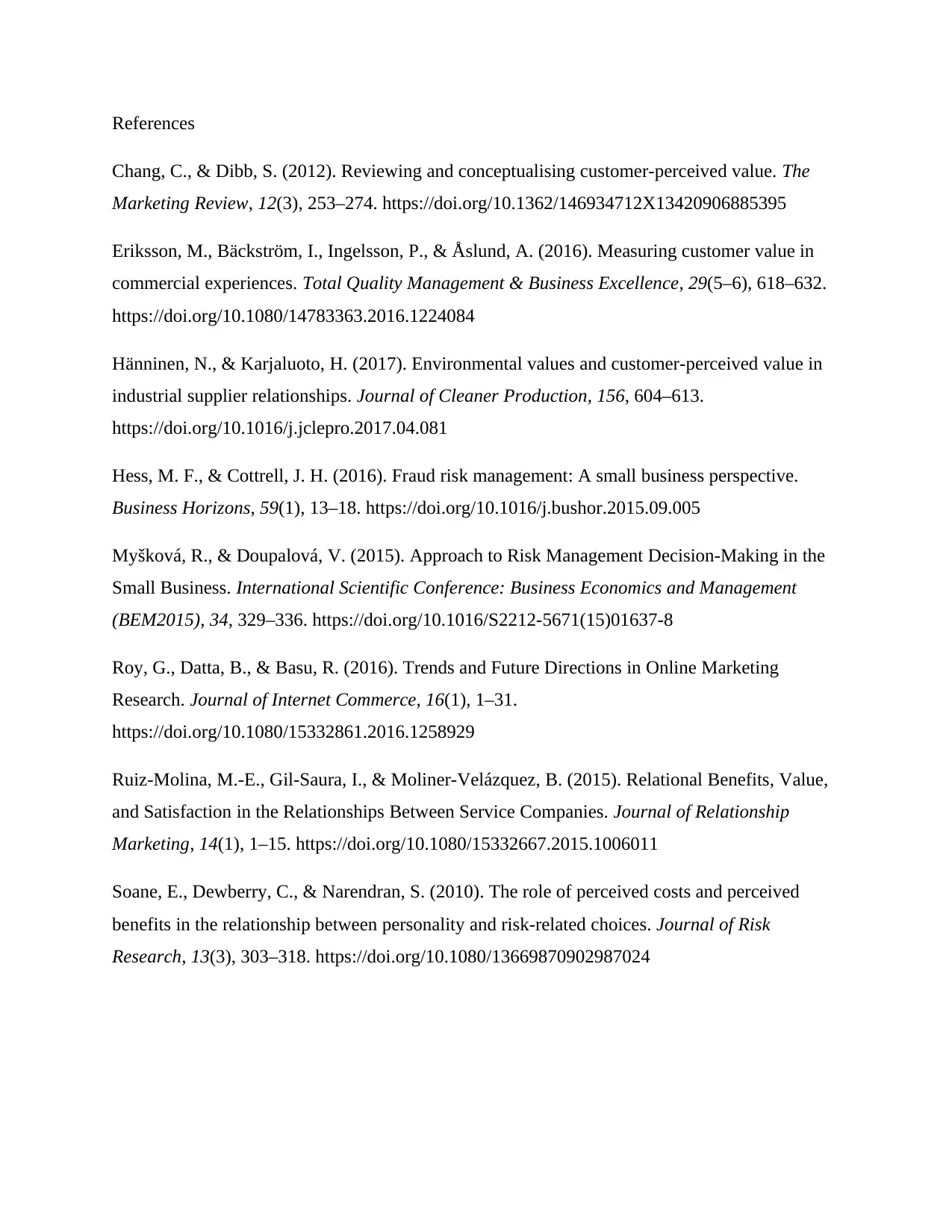
References
Chang, C., & Dibb, S. (2012). Reviewing and conceptualising customer-perceived value. The
Marketing Review, 12(3), 253–274. https://doi.org/10.1362/146934712X13420906885395
Eriksson, M., Bäckström, I., Ingelsson, P., & Åslund, A. (2016). Measuring customer value in
commercial experiences. Total Quality Management & Business Excellence, 29(5–6), 618–632.
https://doi.org/10.1080/14783363.2016.1224084
Hänninen, N., & Karjaluoto, H. (2017). Environmental values and customer-perceived value in
industrial supplier relationships. Journal of Cleaner Production, 156, 604–613.
https://doi.org/10.1016/j.jclepro.2017.04.081
Hess, M. F., & Cottrell, J. H. (2016). Fraud risk management: A small business perspective.
Business Horizons, 59(1), 13–18. https://doi.org/10.1016/j.bushor.2015.09.005
Myšková, R., & Doupalová, V. (2015). Approach to Risk Management Decision-Making in the
Small Business. International Scientific Conference: Business Economics and Management
(BEM2015), 34, 329–336. https://doi.org/10.1016/S2212-5671(15)01637-8
Roy, G., Datta, B., & Basu, R. (2016). Trends and Future Directions in Online Marketing
Research. Journal of Internet Commerce, 16(1), 1–31.
https://doi.org/10.1080/15332861.2016.1258929
Ruiz-Molina, M.-E., Gil-Saura, I., & Moliner-Velázquez, B. (2015). Relational Benefits, Value,
and Satisfaction in the Relationships Between Service Companies. Journal of Relationship
Marketing, 14(1), 1–15. https://doi.org/10.1080/15332667.2015.1006011
Soane, E., Dewberry, C., & Narendran, S. (2010). The role of perceived costs and perceived
benefits in the relationship between personality and risk‐related choices. Journal of Risk
Research, 13(3), 303–318. https://doi.org/10.1080/13669870902987024
Chang, C., & Dibb, S. (2012). Reviewing and conceptualising customer-perceived value. The
Marketing Review, 12(3), 253–274. https://doi.org/10.1362/146934712X13420906885395
Eriksson, M., Bäckström, I., Ingelsson, P., & Åslund, A. (2016). Measuring customer value in
commercial experiences. Total Quality Management & Business Excellence, 29(5–6), 618–632.
https://doi.org/10.1080/14783363.2016.1224084
Hänninen, N., & Karjaluoto, H. (2017). Environmental values and customer-perceived value in
industrial supplier relationships. Journal of Cleaner Production, 156, 604–613.
https://doi.org/10.1016/j.jclepro.2017.04.081
Hess, M. F., & Cottrell, J. H. (2016). Fraud risk management: A small business perspective.
Business Horizons, 59(1), 13–18. https://doi.org/10.1016/j.bushor.2015.09.005
Myšková, R., & Doupalová, V. (2015). Approach to Risk Management Decision-Making in the
Small Business. International Scientific Conference: Business Economics and Management
(BEM2015), 34, 329–336. https://doi.org/10.1016/S2212-5671(15)01637-8
Roy, G., Datta, B., & Basu, R. (2016). Trends and Future Directions in Online Marketing
Research. Journal of Internet Commerce, 16(1), 1–31.
https://doi.org/10.1080/15332861.2016.1258929
Ruiz-Molina, M.-E., Gil-Saura, I., & Moliner-Velázquez, B. (2015). Relational Benefits, Value,
and Satisfaction in the Relationships Between Service Companies. Journal of Relationship
Marketing, 14(1), 1–15. https://doi.org/10.1080/15332667.2015.1006011
Soane, E., Dewberry, C., & Narendran, S. (2010). The role of perceived costs and perceived
benefits in the relationship between personality and risk‐related choices. Journal of Risk
Research, 13(3), 303–318. https://doi.org/10.1080/13669870902987024
1 out of 5
Your All-in-One AI-Powered Toolkit for Academic Success.
+13062052269
info@desklib.com
Available 24*7 on WhatsApp / Email
![[object Object]](/_next/static/media/star-bottom.7253800d.svg)
Unlock your academic potential
Copyright © 2020–2025 A2Z Services. All Rights Reserved. Developed and managed by ZUCOL.

